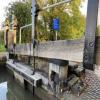
Duke's Lock No 44

This is a lock with a rise of 5 feet and 4 inches.
| Western Bypass Bridge | 2¼ furlongs | |
| Lift Bridge No 233 (Oxford Canal) | 2 furlongs | |
| Northern Bypass Road Bridge No 232A | 1¼ furlongs | |
| Wolvercote Junction Moorings | ½ furlongs | |
| Wolvercote Junction | ¼ furlongs | |
| Duke's Lock No 44 | ||
| Wolvercote Junction Water Point | ½ furlongs | |
| Drinkwater's Field Bridge No 231A | 2¼ furlongs | |
| Drinkwater's Lift Bridge No 231 | 2½ furlongs | |
| King's Bridge No 230 | 4¼ furlongs | |
| Site of Alchemy Boatbuilders | 4¾ furlongs | |
It's known as Shuttleworths Lock after a long standing lock keeper who lived in the cottage.
- Oxford Canal Walk - Part One - Oxford to Thrupp - YouTube — associated with Oxford Canal
- A walk along the Oxford Canal (Southern Section) from Oxford to Thrupp Wide
Mouseover for more information or show routes to facility
Nearest water point
In the direction of Napton Junction
In the direction of End of Hythe Bridge Arm
Nearest rubbish disposal
In the direction of Napton Junction
In the direction of End of Hythe Bridge Arm
Nearest chemical toilet disposal
In the direction of Napton Junction
In the direction of End of Hythe Bridge Arm
Nearest place to turn
In the direction of Napton Junction
In the direction of End of Hythe Bridge Arm
Nearest self-operated pump-out
In the direction of Napton Junction
In the direction of End of Hythe Bridge Arm
Nearest boatyard pump-out
In the direction of Napton Junction
In the direction of End of Hythe Bridge Arm
Wikipedia has a page about Duke's Lock
A duke (male) can either be a monarch ranked below the emperor, king, and grand duke ruling over a duchy or a member of royalty or nobility, historically of highest rank, below princes of nobility and grand dukes. The title comes from French duc, itself from the Latin dux, 'leader', a term used in republican Rome to refer to a military commander without an official rank (particularly one of Germanic or Celtic origin), and later coming to mean the leading military commander of a province. In most countries, the word duchess is the female equivalent.
Following the reforms of Diocletian which separated the civilian and military administrations of the Roman provinces, a dux became the military commander in each province. The title dux, Hellenised to doux, survived in the Eastern Roman Empire where it continued in several contexts, signifying a rank equivalent to a captain or general. Later on, in the 11th century, the title Megas Doux was introduced for the post of commander-in-chief of the entire navy.
During the Middle Ages the title (as Herzog) signified first among the Germanic monarchies. Dukes were the rulers of the provinces and the superiors of the counts in the cities and later, in the feudal monarchies, the highest-ranking peers of the king. A duke may or may not be, ipso facto, a member of the nation's peerage: in the United Kingdom and Spain all dukes are/were also peers of the realm, in France some were and some were not, while the term is not applicable to dukedoms of other nations, even where an institution similar to the peerage (e.g. Grandeeship, Imperial Diet, Hungarian House of Magnates) existed.
During the 19th century, many of the smaller German and Italian states were ruled by Dukes or Grand Dukes. But at present, with the exception of the Grand Duchy of Luxembourg, there are no dukes ruling as monarchs. Duke remains the highest hereditary title (aside from titles borne by a reigning or formerly reigning dynasty) in Portugal (though now a republic), Spain, and the United Kingdom. In Sweden, members of the Royal Family are given a personal dukedom at birth. The Pope, as a temporal sovereign, has also, though rarely, granted the title of Duke or Duchess to persons for services to the Holy See. In some realms the relative status of "duke" and "prince", as titles borne by the nobility rather than by members of reigning dynasties, varied—e.g., in Italy and Germany.
A woman who holds in her own right the title to such duchy or dukedom, or is married to a duke, is normally styled duchess. Queen Elizabeth II, however, is known by tradition as Duke of Normandy in the Channel Islands and Duke of Lancaster in Lancashire.








































